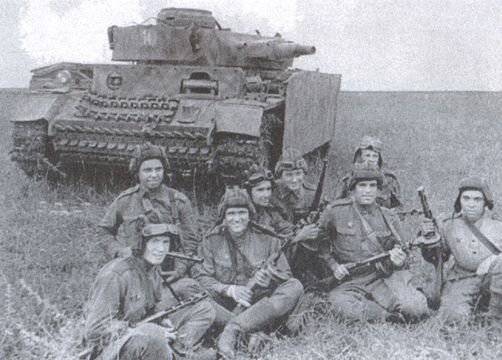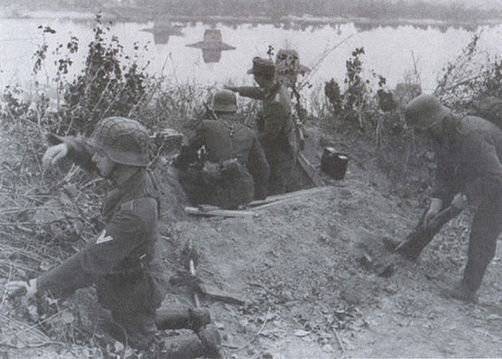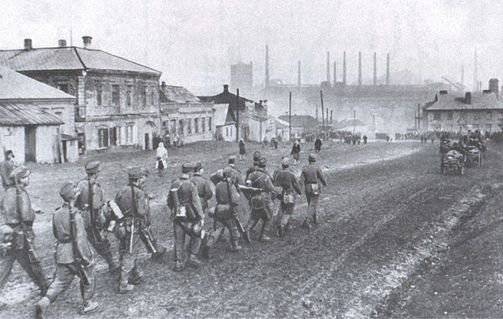Battle for Donbass. Mius-Front Breakthrough

On July 17, troops of the Southwestern and Southern Fronts launched an offensive against the 6th and 1st tank armies of the Wehrmacht. The Red Army was advancing from Izyum to Krasnoarmeysk by the forces of the South-Western Front and from Kuibyshev to Stalin by forces of the Southern Front with the task of breaking up the German group and liberating the Donbass. By August 1, 1943, the Wehrmacht was able to liquidate the breakthrough of the Mius Front by Soviet troops and again reached the Mius River line in the vicinity of the villages of Kuybyshevo - Dmitrovka, until August 18 there was a lull.
Mius front
Fortified defensive line of the German armed forces on the West Bank. Mius entered into history as "Mius Front". It was created in December 1941 of the year and during two winter campaigns was a support for the German forces retreating under the blows of the Red Army. This fortified line was due to the retreat of Army Group South from Rostov-on-Don in November and early December of 1941. The West Bank Mius towered above the east and created favorable opportunities for the construction of a defensive line.
At the turn of the river. Mius German troops left in October 1941 of the year. November 20 Wehrmacht entered Rostov-on-Don. On November 28, Soviet troops under the command of S. K. Timoshenko, after a cruel and bloody battle, fought off the city. Field Marshal Gerd von Rundstedt, commander of the Yug group, was forced to order a retreat, although Hitler did not give permission to withdraw his troops to the line along the r. Mius. Soviet troops tried to break through the German defense, but could not.
During the winter 1941-1942. the Germans created a dense defense on the river. By the spring, the Germans had built an advanced system of trenches, minefields, anti-tank ditches and wire barriers. The defense was strengthened by the chains of pillboxes and pillboxes, machine-gun nests (up to 20-30 units per kilometer) and artillery positions, as well as dozens of settlements, turned into nodes of resistance, with a circular defense.
In the spring of 1942, the Soviet command prepared an operation in this direction. The troops of the Southern Front, commanded by R. Ya. Malinovsky, were to cut off the ledge between Matveyev Kurgan and Sambek with a sudden blow, to release Taganrog. The depth of the planned operation was relatively small - about 40 kilometers. She was supposed to spend the day in 2-3. The operation was to take part 4 divisions and 6 56 Army brigades, with the support of 260 guns and 60 tanks. From the reserves Rates for the operation identified the 3-th Guards Rifle Corps, which was based on the 2-I Guards Rifle Division, and a tank brigade. The offensive also took part naval infantry brigades. 8 March 1942, the Soviet troops launched an offensive, but failed to break through the powerful German defenses. 14 March and 24-26 March 1942, the new attempts of the Red Army to crack the German defense failed.

German post on the Seversky Donets.
In the summer of 1942, the Wehrmacht launched an offensive on the Volga, Kuban and the Caucasus. Mius-front was left in the rear. After the defeat of the German troops at Stalingrad and in the battle for the Caucasus, the Mius-Front was again needed. It was taken in February 1943 by troops deployed from other sectors of the front and from the west. 14 February 1943, the formation of the Southern Front liberated Rostov and continued to move west. The mobile units of the front received the task of developing success in a westerly direction, forcing the Mius River and occupying the Anastasiyevka area. By the end of February 17, the 4 Guards Mechanized Corps in the area of Matveyev Kurgan forced the river, and on the shoulders of the retreating Germans burst into Anastasievka. It should be noted that by this time there were only 14 tanks in the hull, he was exhausted by the previous battles. 2-th and 3-th Guards mechanized corps went to the river only February 20, because waiting for the supply of fuel. The rifle units also fell behind, and only two regiments of the 4 Guards rifle division managed to cross at the 33 Guards Mechanized Corps.
The German command took advantage of the separation of advanced Soviet units from the main forces and on the night of February 20 closed the gap in the area of Matveyev Kurgan. 4-th Guards Mechanized Corps and two rifle regiments were in the "boiler" in the area of Anastasiyevka. 2 and 3 of the Guards Mechanized Corps and units of the 2 of the Guards Army attempted to unlock those who were surrounded, but they could not. On the night of February 22, on the orders of the command, the encirclement made their way to their own. Until the end of the month, Soviet troops tried to break through the German defense, but did not succeed. The front line has stabilized for several months.

The entry of the Germans in Stalin.
July offensive
In the spring and summer of 1943, the Wehrmacht and the Red Army prepared for a decisive battle. After a successful strike in the area of the Kursk bulge, the German command planned to strike at the rear of the Southwestern Front. The troops of the South-Western and Southern fronts were to play an important role in the Battle of Kursk. Their forces were to proceed to active offensive actions in order to deprive the German command of the ability to maneuver their reserves and transfer forces to the Kursk direction from other sectors of the Soviet-German front. The South-Western and Southern fronts were to go on the offensive and, by their actions, tie up the Donbass grouping of the Wehrmacht. The July offensive of the Soviet troops in the Donbass direction played an important role in the Battle of Kursk. The German command dismantled the shock grouping of the 4 tank army on the southern flank of the Kursk Bulge, and it quickly began to deploy troops to the Mius Front and into the defense zone of the 1 tank army.
By the beginning of the Great Battle of Kursk, the front section from the Sea of Azov to Kharkov was stable, both sides were digging in and doing serious engineering work. By July, the German troops had a powerful, deeply echeloned defense on the Mius Front, which consisted of 2-3 bands. The first (main) line of defense had a depth of 6 – 8 km, and in some areas up to 10 – 12 km. The second defensive line was well prepared in engineering. In 40 – 50 km west of the Seversky Donets and Mius, a third army band was built. Anti-personnel and anti-tank fields were widely used in defensive orders, with depths of fields up to 200 meters and with a density of 1,5-1,8 kths of a min. On 1 km of the front on the right bank of the Seversky Donets, the average density of the fortification equipment of the area was: 1960 running meters of trenches and communications, 1640 running meters of anti-personnel obstacles, 9 dugouts, dugouts, 4 bunker and 151 open machine gun point. Here nature itself helped to create defensive lines: the area was an open hilly plain, heavily carved with gullies, ravines and heights. The leading edge of the German defense was mainly along the right, high, and in some places steep bank of the Seversky Donets and Mius. Numerous heights allowed a good view of the terrain and create fortified positions on them. All this prevented the offensive and strengthened the Wehrmacht's anti-tank defense. Especially powerful defense was on the Mius-front.
The Donbass bridgehead of the German troops was part of the Belgorod-Kharkov bridgehead and its defense tasks were solved by the 1-I tank, 6-I armies and part of the forces of the Kempf task force from the Army group South. In total, the German command had 27 divisions in this area, including 5 tank and 1 motorized. In the first line of defense was located 22 division. The operational reserve was 5 divisions - 3 tank, 1 motorized and 1 infantry. In general, despite the power of engineering structures, the density of the defensive orders of the German troops was low - 15 – 20 km, and in some places up to 30 km per division. As a rule, all regiments of infantry divisions were built in one line, and not echeloned into depth. In the reserve of the division there were only up to two infantry battalions, in the reserve of the corps there were 1-2 infantry battalions and special auxiliary units. The second line of defense was not occupied at all by the troops, it should have been beaten by the divisions from the first (main) line, at its breakthrough. The stability of the defense was achieved by a quick maneuver of tactical and operational reserves. In the event of a serious crisis, it was necessary to rely only on the transfer of troops from other sectors of the Soviet-German front.
On July 7, at the direction of the Supreme Command Headquarters, the troops of the South-Western and Southern Fronts began preparations for an offensive operation. The South-Western Front, commanded by Rodion Malinovsky, delivered a concentric blow from Izyum to Krasnoarmeysk, the Southern Front of Fyodor Tolbukhin from Kuybyshev to Stalino. To the beginning of the operation, the South-Western Front held defenses along the left bank of the Seversky Donets River. It consisted of 6-I, 12-I, 57-I and 1-I, 8-I, 3-I guards armies, as well as 17-I air army. The troops of the South-Western Front occupied a covering position in relation to the Donbass grouping of the Wehrmacht, which created favorable conditions for striking the enemy troops. The South-Western Front was opposed by the 1 Tank Army under the command of Eberhard von Mackensen and part of the Kempf group.
The offensive of the South-Western Front. Malinovsky decided to concentrate his main efforts in the center, on the direction of Barvenkovo - Krasnoarmeisk. The main attack was carried out by the adjacent flanks of the 8 and 1 of the Guards armies. Soviet troops used a bridgehead in the area of Izyum, and were forced to cross the Seversky Donets south-west and south-east of this city. In the second echelon of the advancing troops was the 12-I army. Her troops were to enter the breakthrough and build on the success of the first-line armies. The troops of the South-Western Front were to develop an offensive south-westward on 5-7 the day after the start of the operation, go through 100 – 120 km and reach the line of Grushevakha - Gemini - Petropavlovka - Krasnoarmeysk - Konstantinovka. The mobile units of the front — the 23 tank and 1 guards mechanized corps, advancing on the tip of the 12 army, were to go to the Stalin area and complete the encirclement and defeat of the enemy’s 6 army together with the units of the Southern Front. The troops of the 3 Guards Army delivered an auxiliary strike on the left wing of the front, using a bridgehead at Privolnoye. They attacked from the area Lysychansk - Privolnoe in the general direction of Artemovsk. The armies of the right wing of the front 6-I and 57-I were to continue to keep the defense.
Early in the morning of July 17, 1943, an artillery and aviation training. The 1st Guards Army, led by Vasily Kuznetsov, concentrated its main efforts on its left flank. It consisted of 8 rifle divisions and 3 tank brigades. The guardsmen had to break through the German defense in the Chervonny Shakhtar-Semenovka section and then advance along the Barvenkovo-Petropavlovka line. Parts of the 4th Guards Rifle Corps successfully crossed the North Donets and attacked the positions of the 257th Infantry Division of the enemy. The guards met a flurry of artillery, mortar and machine gun fire, the Germans repeatedly went on the counterattack, trying to throw Soviet troops into the river. Groups of German aircraft attacked Soviet troops.
The 8-I Guards Army, under the leadership of Vasily Chuikov, advanced on its right flank, on the Kamenka sector - Cenicheno. The army troops were lined up in two echelons: in the first echelon there were two rifle corps - the 29-th Guards and 33-th, in the second - the 28-th Guards rifle corps. The army was advancing in the direction of Krasnoarmeysk. To capture bridgeheads in the regiments, shock battalions reinforced with artillery and mortars were formed. Part of the 33 Infantry Corps, which operated on the left flank of the army, was particularly successful. The arrows, forcing the river and repelling the enemy's counterattacks, advanced from the coast to 6 km. This made it possible to proceed with the construction of a 89 meter crossing. In 11 hours the construction of the crossing was completed.
29-th Guards Rifle Corps met a stronger resistance of the enemy. However, two crossings were erected on its site, one with a lifting capacity of 16 tons, and the second - on 60 tons (in total, on the first day of the offensive, they planned to build the 4 crossing). Subsequently, temporary floating bridges and pontoon ferries were replaced with wooden bridges on permanent supports (on the sixth day of operation, four such bridges were built). In the afternoon of July 17, the German command deployed the 33 Infantry Division from the reserve to the battlefield and pushed the Soviet troops in the area north of the village of Khrestishche.
On July 18, the 28 th Guards Rifle Corps was brought into battle, it was to advance south to the west of Slavyansk. On the same day, in the offensive zone of the 29 Guards Rifle Corps, they were thrown into the battle of the unit of the 1 Guards Mechanized Corps, he was to develop an offensive against Krasnoarmeysk along with the 23 tank corps. However, German troops continued to be held in the main defense zone, while Soviet troops advanced slowly. There were stubborn fights. The Germans more than once went on the counter. Actively operated German aircraft.
Fierce battles continued on other sectors of the front. 3-th Guards Army for ten days of stubborn fighting took on the right bank of the riverhead on the front on 36 km and in depth on 3 – 5 km. 27 July, the army of the Southwestern Front moved to the defense. The front achieved limited success, but failed to break through the German defenses. This was due to the extremely serious defense of the enemy in this direction and the skillful actions of the enemy forces. The Germans daily launched several counterattacks against our troops, in some areas up to 13-18 counterattacks a day. Large interference was caused by German aviation, which bombed Soviet troops and ferries in large groups. During the 10 days of battles, we counted up the 2600 enemy sorties. In addition, the German command transferred to the Donbass strong quantitatively and qualitatively strong units of the 24 tank corps, the 2 CC tank corps. By their actions, the troops of the South-Western Front rendered great assistance to the forces of the Voronezh and Steppe Fronts, which repelled the enemy's attack on the southern face of the Kursk Bulge.

The situation on the southern sector of the Soviet-German front by July 1943. The plan of operations of the South-Western and Southern fronts. Source: M.A. Zhirokhov Battle for Donbass. Mius-front. 1941 – 1943
South front. The front consisted of 51-I, 28-I and 44-I armies, 5-I shock, 2-I guards army, 8-I air army. The southern front under the command of Tolbukhin acted against the troops of the 6 Army under the command of Karl-Adolf Hollidt. The strike force front struck in the center from the line Dmitrievka - Kuybyshevo - Yasinovsky, with a length of about 30 kilometers. The southern front was to smash the Wehrmacht Taganrog grouping, free Taganrog, reach the line of the Elanchik River, and from there step on Stalino, to join the troops of the South-West Fleet.
51-I army on the right wing of the front received the task of delivering an auxiliary blow to Petrovo-Krasnoselie. The army included seven rifle divisions, a separate tank brigade. The 5 Shock Army struck in the Dmitrievka area, and had to develop an offensive in the north-west direction. The army consisted of seven rifle divisions, a separate tank brigade and a tank regiment. Four divisions were advancing in the first echelon, two were in the second. The 28 Army received the task of penetrating enemy defenses south of Kuibyshev and developing an offensive to the south-west in order to destroy enemy troops in the Taganrog region. The army had six rifle divisions, a tank brigade and a tank regiment. In the first echelon there were four rifle divisions, tank units, in the second - two rifle divisions. The 44 Army in the three infantry divisions held the line Yasinovka - Primorka and contributed to the attack of the 28 Army. In the second echelon of the front was the 2-I Guards Army, having in its composition six rifle divisions and two mechanized corps. The second echelon of the front was planned to be brought into battle when the forces of the 5 shock and 28 armies would overcome the tactical belt of the enemy's defenses. 2-I Guards Army was to attack on the line Kuteynikovo - Stalino.
The night before the attack, Soviet aircraft struck the German leading edge and the most important defense units. In 6 hours of July 17, after the artillery barrage, ground forces began to attack. Long almost four-hour artillery preparation allowed to force the river and take the advanced positions of the opponent. From the very beginning of the operation, Soviet troops met with strong resistance. Soviet attacks were choked under enemy artillery fire and Luftwaffe strikes. The 5 th shock army under the command of Vyacheslav Tsvetaeva advanced by the end of the first day of the offensive operation from 2 to 6 km. The German command began to pull up their tactical reserves to the place of the emerging breakthrough.
By the end of July 18, Soviet troops captured a small bridgehead on the right bank of the Mius - 10 km deep, about the same in width. The German command was forced to throw into battle from the operational reserve units 16-th motorized division, which was planned to be sent to the area of Kharkov. 28-I army has achieved minor success. The front command ordered the main forces of the 28 Army to be rearranged to the right flank in order to use the relative success of the 5 Shock Army. Regrouping was done during July 19. By this time, the German command began transferring troops from the Belgorod-Kharkov direction.
In the afternoon, 18 July, the command of the Southern Front, without waiting for the success of the shock groups of the 5 shock and 28 armies, led the 2 Guards Army under the command of Jacob Kreizer into battle. The formations of the 2 Guards Army, interacting with units of the 5 shock and 28 armies, advanced into the depths of the German defense. Took several settlements. The German command transferred units of the 23 tank division to the battle area, which they returned halfway to Kharkov, as well as the 336 infantry division, and some other units. The activity of German aviation increased even more.
The command of the Southern Front began a regrouping of forces in order to launch the 31 of July 1943 on the offensive with the general direction of the Assumption. However, the advance of the troops of the Southern Front did not have time. On July XN, elite SS tank armies deployed from the Kursk sector, Dead Head, Reich, and 29-I tank divisions appeared in the battle area. On July 3-30, German troops, supported by large Luftwaffe forces, launched strong counterattacks against Soviet forces. The southern front could not penetrate the German and defense and began to withdraw troops to the left bank of Mius. By August 31 the front was stabilized.
The July offensive of the South-Western and Southern fronts on the Seversky Donets and on the Mius did not bring the success of the Red Army. Donbass enemy grouping retained their previous positions. However, this operation had strategic consequences on other sectors of the Soviet-German front. Soviet troops did not allow the German command to transfer some of the forces from the Donbass area to the Kursk salient, reinforcing the attack groups during the offensive operation "Citadel". Moreover, the German command had to withdraw from the Kursk sector up to five tank divisions, as well as significant aviation forces, and redeploy them to hold positions on the Seversky Donets and Mius. This weakened the Belgorod-Kharkov grouping of the Wehrmacht and created more favorable conditions for the operation of the Rumyantsev by the forces of the Voronezh and Steppe Fronts. Thus, the troops of the South-Western and Southern decided the main task - they did not give the German command to use all the operational reserves of Army Group South in the operation of the Citadel and pulled the enemy’s significant forces from the Kursk Bulge.
To be continued ...
- Alexander Samsonov
- Battle for Donbass. Mius-Front Breakthrough
Battle for Donbass. Breakthrough Mius-front. Part of 2
Battle for Donbass. Breakthrough Mius-front. Part of 3
Battle for Donbass. Breakthrough Mius-front. Part of 4
Battle for Donbass. Breakthrough Mius-front. Part of 5
Information